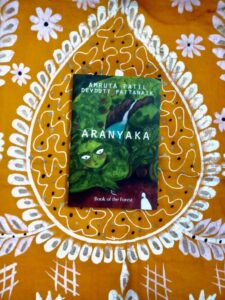
When we juxtapose Prakriti or nature with Sanskriti or Culture in light of the Vedas, we imagine the former as savage and ruled by the law of domination. The culture is always against the law of the jungle. It upholds itself as a place where the weak are protected by the strong. It is either this untamed imagery or the highly romanticized symbolisms that are associated with the forests. Forests are often viewed with respect to themes of detachment, independence from worldly matters. However, have we ever wondered how Vedic essence can be applied to the forests? Did we consider- how would merging the savage and aesthetic perspective of forests result in? Amruta Patil and Devdutt Pattanaik, unravels these questions in their collaborative Graphic Novel- Arayanka.
The story begins with Katyayani-the large. She is called so because has a large hunger which outsizes the community’s food resource. Katyayani is banished to the forest- the region of savagery, when she eats the prasad or the food solely reserved for the gods. Thus, begins her journeys as does ours. The reader gets to explore with Katyayani the relation of dependency-interdependency in the untamed territory and beyond it. Along the way we meet other characters such as Y- a hermit, the pragmatic weaver and others who add depth in the novel. All of them are based on the well known personas of the Vedic lore (Spoiler Alert!). The collaborators also tease readers with references from Greek mythology, Buddhist Sutras, and Chinese proverbs to Bhakti movement’s female poets like Karaikal Ammaiyar. The Harappan Dancing girl figurine too makes a cameo! The new reader might ask ‘Isn’t it too much? Too many cooks spoil the broth, don’t they?’ or ‘Can a Graphic Novel fit all these philosophies, isn’t it a distraction to the story-line?’
The answer is a simple no! One must not forget that both the collaborators are seasoned authors. They do not throw us into the jungle and leave us to tackle the unknown. Rather they create Katyayani’s journey which acts as a trail for us to follow. The water-color and water soluble pencil art work add lucidity to the narrative. Also, towards the end of this dense journey there is a light in the form of the section titled ‘Making Aranyaka’. In this section we get special insights from the co-authors about how every element is weaved together.
Aside from all this we can even consider the eco-feminist aspect of the graphic novel. Ecofeminism primarily deals with the relation between women and nature. Katyayani follows the iti-iti philosophy i.e. she connects with this and that in nature. As other female characters like the ‘Weaver’, the ‘Fig’ enters the story; her understanding of human nature also grows. However, in contrast to Katyayani, her partner, the hermit’s perspective is to negate material relationships. It is a path to ultimate knowledge. How does a household fare, when the personalities of the partners are opposite? What effect does the coming of the other female characters have on the relationship between the hermit and Katyayani? Is it just about Katyayani and her relationship with the forest? All this the reader must find out for themselves.
With this being said, the vision of the creators is successfully tied together in the Graphic Novel. It is one of a kind blend in the genre of Mythological retelling and Graphic Novel. And we expected nothing less from Devdutt Pattnaik and Amruta Patil. The former, with 50 books and various television and Radio is a household name when it comes to Indian mythology. On the other hand Amruta Patil is India’s first female graphic novelist and a writer-painter. She is the author of Kari and a Nari Shakti Puraskar awardee.
If you liked the above recommendation then explore these works by Amrita Patil too:
- Sauptik: Blood and flowers
- Adi Parva
Some popular works by Devdutt Pattanaik are:
- Myth=Mithya: A Handbook of Hindu Mythology
- The Book of Ram
- Sita: An Illustrated Retelling of the Ramayana
- Shikhandi: And Other Tales They Don’t Tell You